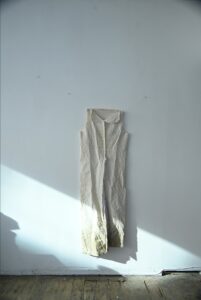
In the destination is not freedom

To decipher Paula Ballo Dailey one must immediately understand she was terminally ill.
From her diagnosis of cancer until her death in 2016, a mere two months passed. She had started on some of her work and consequently finished it within that time frame with great help from caretaker and artist husband, Brian.
Paula had accumulated a great deal of “thing-age” from her home area in the Shenandoah Valley, Woodstock Virginia. Her highly selective vocabulary “pieces” of yard sales, junk sale- antique objects implemented as “color words” in her constructions have a more poetic sense than that of a visual piece. This is no accident. She wrote volumes of note books. Her words of fear and hope and observations were discovered by her husband after her passing. He told me he would have encouraged her to publicize her writing. This was her inner self revealing its life-self to her conscious self, as if “hatching” personal ideas from which to “escape” with, then to be entrusted in her works.
A great many artists create a private language or vocabulary to reconcile themselves to this world, but Paula, she had a foot in the next one as well. This was a life long vision, as still and reserved and ”inner” as it might be. Her work is about her self’s movement from this station to what may come- this is how she had dealt largely with her death process … by embracing it on her own terms. Calmly, not angry, not afraid. If we examine her piece “Lives Matter” we see two roosters ,one bottom left , the other top right, a framed bed of flower feathers and on that a carousel of color wheel wound thread, in a circle of course … a white thread attached to / from the bottom left rooster and a colored thread to the upper right rooster. The piece moves through the frame to the top to the more colored rooster—i.e. a higher state … color is, in this case, the greater power or advancement or higher insight or greater position or the transcendence from which it evolves … willingly accepted by the hands of a human in different positions, a trusted movement of herself. Paula was fascinated by birds and cages. This work implies work to achieve a higher view. The upper right rooster has more color, something that is gained by moving through the color feather garden. This is hope for Paula. There is travel. There is work. There is some sense of higher learning not of this dimension.
In The Destination is Not Freedom, we have another bird theme, i.e. the egg and another bird cage this time with Buddha sitting on a bed of nails inside the cage with an open door. Can Buddha stop suffering to get off the bed of nails inside the cage and walk out? As painful as it is to be on Earth i.e. the cage he is in progress to be “hatched” – note the ostrich egg below the cage in wood— the wood is in Earth and the tools to enlightenment— the scrips of spirit and the bowl of sacred herbs are just beyond the cage. Clearly he will, in time get off his bed of nails, flee the cage and enjoy enlightenment— freedom. To make sure this will happen, a tablet of Buddhist prayers is situated on the top of the cage— for his continued growth, progress, movement, journey, path. A certainty to Paula.
Paula identified with her cage.. the problems in this life as struggle and yet the power to transcend them in her “Self Portrait”. Once again a cage and a cage door open, movement to be. A life on earth, within the cage—her own picture, a Renaissance Leonardo Mary— a classical Greek statue or is it a miniature Rodin? – a paint box, she acknowledges art, artfully, a doll and birds … inside and out of the cage. The table the cage sits on has an open drawer full of old snapshots, memories, time passing. On top of the cage is a man’s hat—God? What she knows is the open door, her launch pad from the Earth and her world here to a next, a woman in transcendence on the move to who knows where. …? Paula’s work prompts the sense of mystery in us.
Perhaps this is best expressed in her earlier work “My Rebirth”. She sonically projects herself forward in space, the energy of the cosmos and clouds propelling her forward, at us, the viewers. She is fragmented, vibrating forth but powerfully, confidently, unmistakably ….she is on her journey. And we are invited to know this. The question is– can we?
Al Jirikowic
Editor, Washington DC
Volume 31 no.6 July / August 2017 p 35

